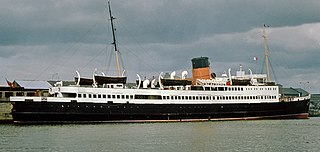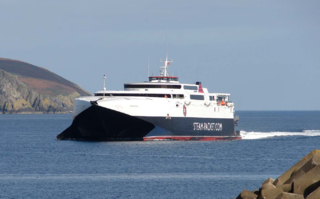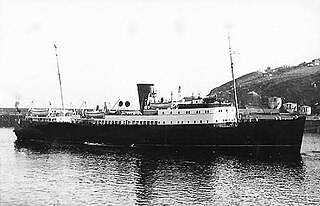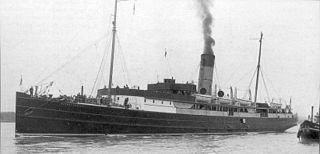
Cunard Line is a British cruise line based at Carnival House at Southampton, England, operated by Carnival UK and owned by Carnival Corporation & plc. Since 2011, Cunard and its three ships have been registered in Hamilton, Bermuda.

Merseyside is a metropolitan and ceremonial county in North West England, with a population of 1.38 million. It encompasses the metropolitan area centred on both banks of the lower reaches of the Mersey Estuary and comprises five metropolitan boroughs: Knowsley, St Helens, Sefton, Wirral and the city of Liverpool. Merseyside, which was created on 1 April 1974 as a result of the Local Government Act 1972, takes its name from the River Mersey and sits within the historic counties of Lancashire and Cheshire.

Clarence Dock was a dock on the River Mersey, England, and part of the Port of Liverpool. Situated in the northern dock system in Vauxhall, it was connected to Trafalgar Dock.

Liverpool Exchange railway station was a railway station located in the city centre of Liverpool, England. Of the four terminal stations in Liverpool's city centre, Exchange station was the only station not accessed via a tunnel.
Several ships have been named Innisfallen, the name being derived from the island of Innisfallen in County Kerry and often given to vessels serving the southerly coasts of Ireland. Five served on the Irish Sea route between Cork and Fishguard, from 1896 onwards: two of these were war casualties whilst the remainder have been either scrapped or renamed and sold to new owners.

The Isle of Man Steam Packet Company Limited is the oldest continuously operating passenger shipping company in the world, celebrating its 190th anniversary in 2020.

SS (RMS) Ellan Vannin was built as an iron paddle steamer in 1860 at Meadowside, Glasgow for the Isle of Man Steam Packet Company. She was originally named Mona's Isle - the second ship in the company's history to be so named. She served for 23 years under that name before being rebuilt, re-engined and renamed in 1883. As Ellan Vannin she served for a further 26 years before being lost in a storm on 3 December 1909 in Liverpool Bay.

Turbine Steam Ship (RMS) Manxman was a passenger ferry launched from the Cammell Laird shipyard, Birkenhead, on 8 February 1955. She was the final vessel in a class of six similar ships, the Six Sisters, ordered by the Isle of Man Steam Packet Company, and was the second of the Company's ships to carry this name. She was withdrawn from service in 1982. Following a failed preservation attempt, and featuring in a music video in the process, the ship was broken up at Sunderland in 2012.

HSC Hellenic Highspeed is a high-speed craft owned by Hellenic Seaways, having previously being owned by Sea Containers.

The British and Irish Steam Packet Company Limited was a steam packet and passenger ferry company operating between ports in Ireland and in Great Britain between 1836 and 1992. It was latterly popularly called the B&I, and branded as B&I Line.

The Fifteen Guinea Special was the last main-line passenger train to be hauled by steam locomotive power on British Rail on 11 August 1968 before the introduction of a steam ban that started the following day, the extra day added to allow for the movement of locomotive BR Standard Class 7 70013 Oliver Cromwell to Bressingham Steam Museum. It was a special rail tour excursion train organised for the occasion from Liverpool Lime Street via Manchester Victoria to Carlisle and back, and was pulled in turn by four steam locomotives during the four legs of the journey. The last scheduled standard gauge steam-hauled passenger services had run on 3 August 1968 from Preston. Steam continued to be used on the narrow gauge Vale of Rheidol Railway under British Rail, which was subsequently privatised in 1989.

HSC Manannan is a 96-metre (315 ft) wave-piercing high-speed catamaran car ferry built by Incat, Australia in 1998. After commercial service in Australia and New Zealand, she was chartered to the US military as Joint Venture (HSV-X1). Now owned and operated by the Isle of Man Steam Packet Company, she mainly provides a seasonal service between Douglas Harbour and Port of Liverpool.
PS Tredagh was a paddle steamer passenger vessel operated by the Drogheda Steam Packet Company from 1876 to 1902 and the Lancashire and Yorkshire Railway from 1902 to 1912.

TSS (RMS) Fenella (II) No. 145310 was a pre-Second World War passenger steamer built by Vickers Armstrong at Barrow-in-Furness in 1936, for service with the Isle of Man Steam Packet Company. She was sunk by air attack during the evacuation of Dunkirk in May 1940.

SS (RMS) Tynwald (II), No. 45474, was an iron paddle-steamer which served with the Isle of Man Steam Packet Company, and was the second vessel in the Company to bear the name.

SS (RMS) King Orry (I) No. 21923 - the first vessel in the line's history to be so named - was a wooden paddle-steamer which served with the Isle of Man Steam Packet Company.

SS (RMS) Mona (II) No. 76302 was a packet steamer operated by the Isle of Man Steam Packet Company. Mona was the first screw-driven ship in the company's history.

SS (RMS) Snaefell (I) – the first ship in the Company's history to bear the name – was an iron paddle steamer that served with the Isle of Man Steam Packet Company until she was sold in 1875.

SS (RMS) Mona (III), the third ship of the Company to bear the name, was a steel paddle-steamer which was originally owned and operated by the London, Chatham and Dover Railway Company, who then sold her to the Liverpool and Douglas Steamship Company, from whose liquidators she was acquired by the Isle of Man Steam Packet Company in 1903.

The packet steamer SS Rushen Castle was operated by the Isle of Man Steam Packet Company from her purchase in 1928 until she was sold for breaking in 1947.



















